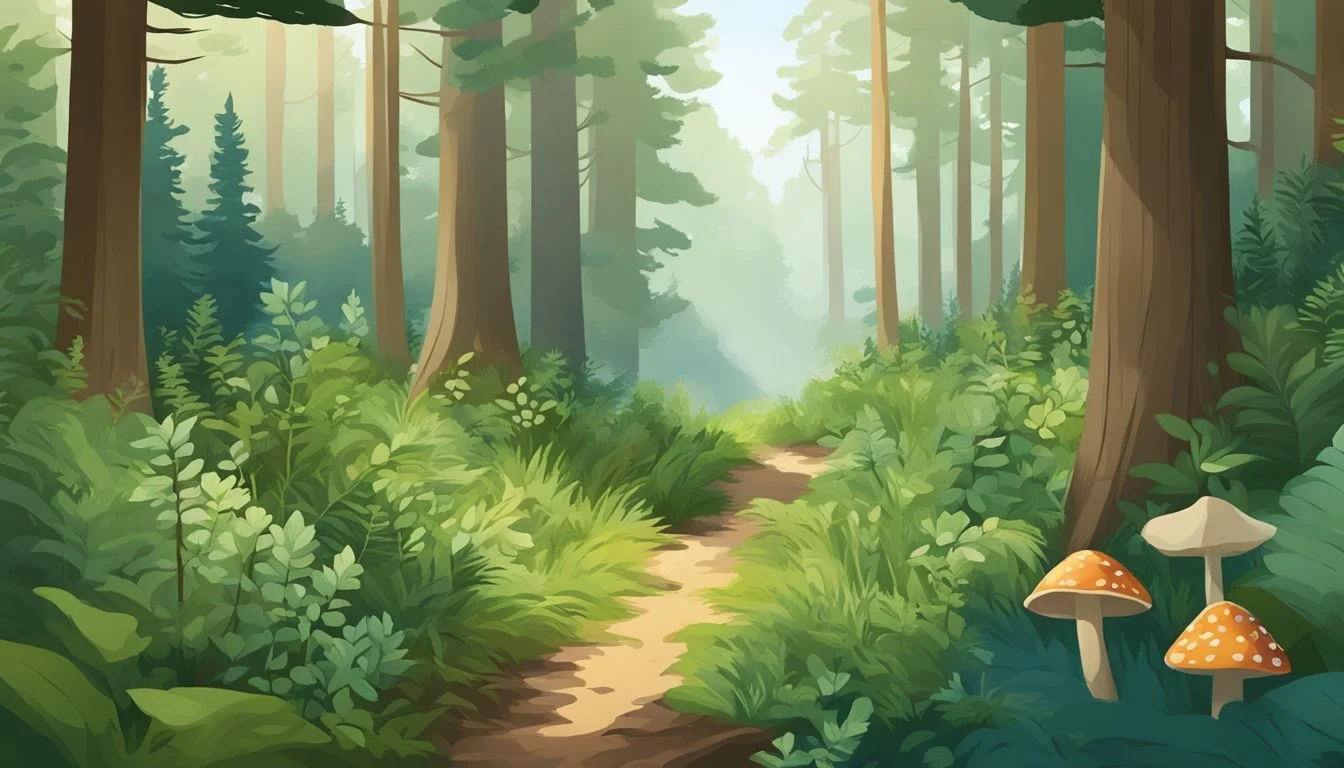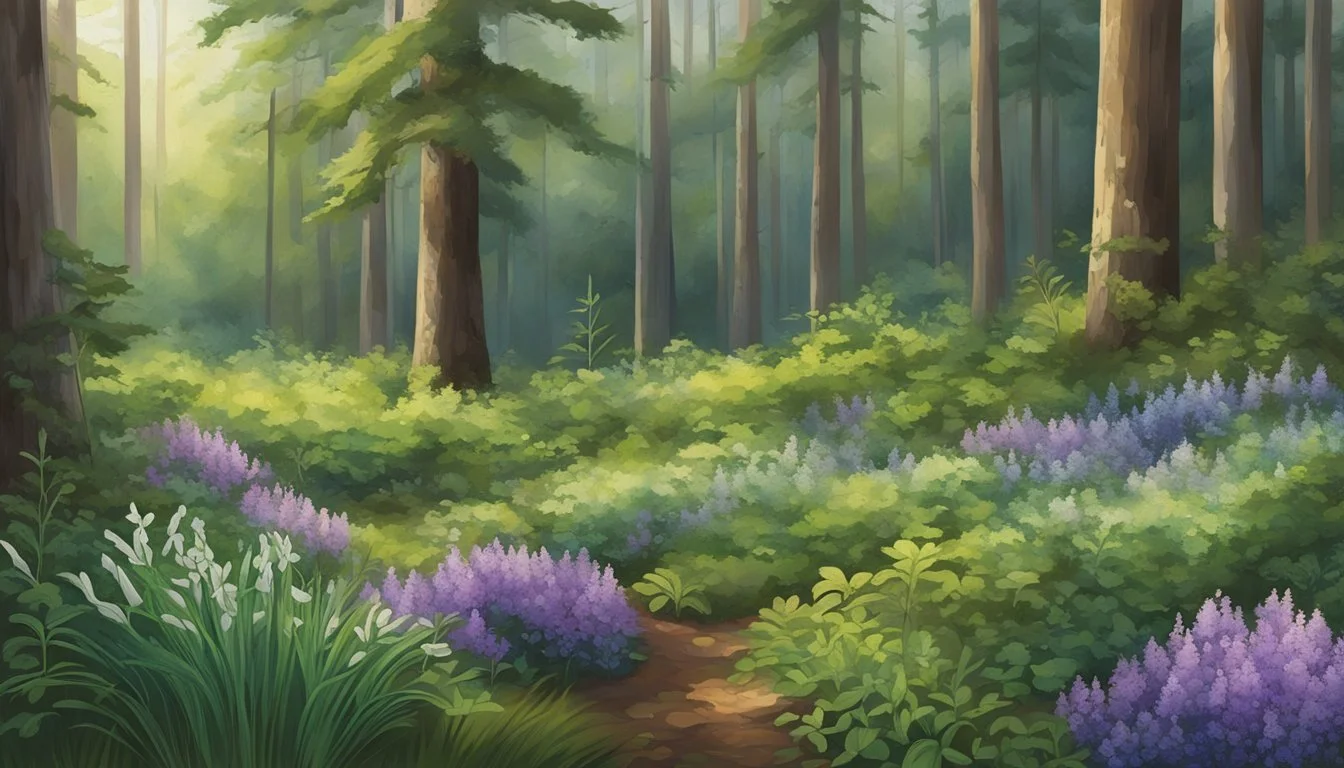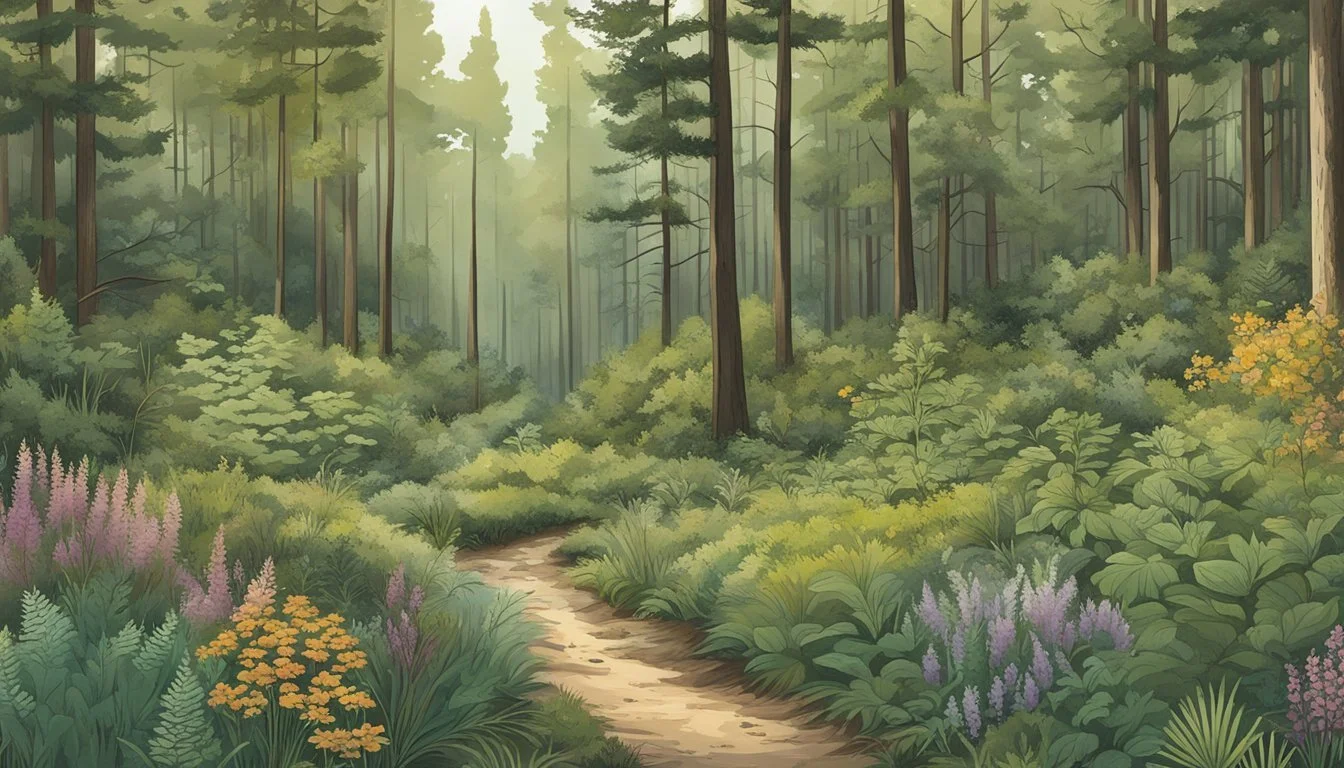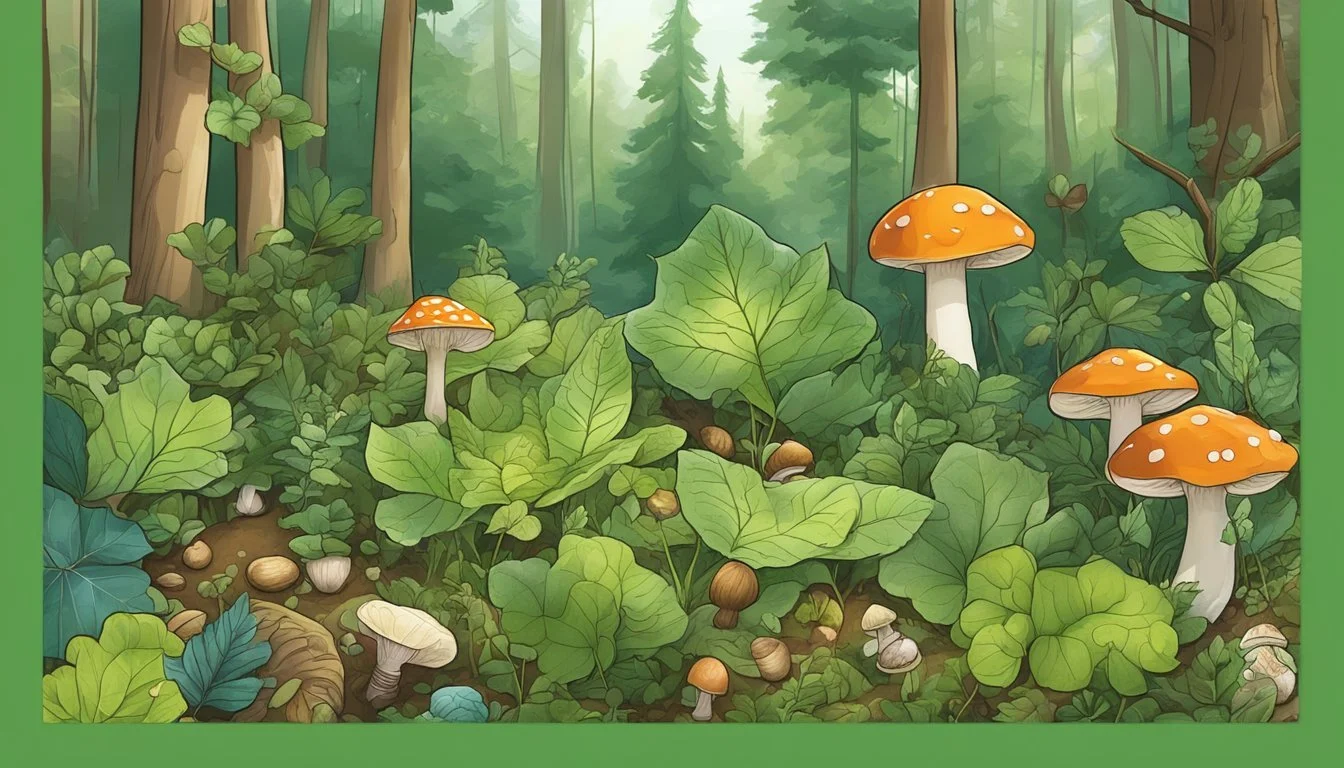Piney Woods Native Edible Plants
A Guide to Wild Foraging
Nestled in the heart of East Texas, the Piney Woods region offers a rich tapestry of native edible plants waiting to be explored. From the sweet fruits of the prickly pear cacti to the versatile pecan tree, these native plants are integral to the region's diverse landscapes. The Piney Woods' lush environment, sustained by 35 to 60 inches of rain per year, supports an array of edible plant species that thrive under its canopy.
The dense forests of loblolly, shortleaf, and longleaf pines provide a unique habitat for woodland specialties such as morels and chanterelles, which can be found by the keen forager. Streams and lowlands, brimming with beech, oaks, elm, and magnolia, are equally prolific, offering an abundance of edible and medicinal plants. This diverse botanical bounty not only contributes to the ecological richness of East Texas but also offers practical and nutritional benefits for those familiar with the local flora.
For hikers and nature enthusiasts visiting the Piney Woods, discovering these plants can be both educational and rewarding. Guided hikes often reveal concealed treasures of nature, from historic medicinal uses to unexpected snacks hidden among the pines. With this knowledge, adventurers can deepen their connection to the land and enjoy the bounties that the Texas Piney Woods have to offer.
Understanding the Piney Woods Ecosystem
The Piney Woods region boasts a rich diversity of flora, significant native plant habitats, a pivotal role of pines in the ecosystem, and vegetation that is heavily influenced by the climate.
Flora Diversity in Piney Woods
The Piney Woods region features a variety of trees, shrubs, vines, and herbaceous plants. Dominant tree species include loblolly, shortleaf, and longleaf pines. Among hardwoods, oak, hickory, and beech trees are also prevalent.
Smaller plants such as ferns, mosses, and pitcher plants thrive in this ecosystem. In wetter areas, sundews and pipeworts can be found. The variety of plant life contributes to a complex and interdependent ecosystem that supports a wide array of wildlife.
Native Plant Habitats
Within the Piney Woods, plant habitats range from dry upland areas to moist lowlands. The streamside stands often have magnolia, elm, and water oak, benefiting from consistent moisture.
Sphagnum bogs create unique acidic environments favorable for specific plants. These diverse habitats ensure the survival of numerous plant species and provide homes for various animal species, creating a rich and thriving ecosystem.
Significance of Pines in the Ecosystem
Pines are the backbone of the Piney Woods ecosystem. Loblolly, shortleaf, and longleaf pines play crucial roles in soil stabilization, water regulation, and providing habitats. They often coexist with other species, forming mixed forests that enhance biodiversity.
Pines also support wildlife like woodpeckers, who nest in cavities pecked into old pine trees. This creates additional habitats for other creatures, highlighting the importance of pines in sustaining the region's ecological balance.
The Climatic Influence on Vegetation
The climate of the Piney Woods, characterized by 35 to 60 inches of annual rainfall, has a profound impact on vegetation. The ample rain supports lush growth and diverse flora.
Seasonal changes, such as spring showers, encourage the growth of many plants. In areas with higher moisture retention, a greater abundance of ferns, mosses, and wetland plants like sundews can be found. The climate plays a central role in shaping the ecosystem and ensuring its health and vitality.
Foraging in the Pineywoods
Exploring the Pineywoods offers rich opportunities to find and identify a variety of edible plants. Understanding ethical foraging practices, learning to identify safe and edible species, and knowing the best times of year to forage are essential.
Basics of Ethical Foraging
Ethical foraging ensures that plant populations remain sustainable and the environment remains undisturbed. Always seek permission before foraging on private lands. Public lands may have specific regulations, so it is important to know the rules of the area.
Harvest only what you need and avoid overharvesting any plant species, especially those that are rare or slow-growing. Leave some plants behind to reproduce and maintain the ecosystem's balance. Be mindful not to disturb wildlife habitats while foraging.
Identifying Edible Plants
Learning to identify edible plants in the Pineywoods is crucial for a safe foraging experience. Common edible plants include morels, chanterelles, and oyster mushrooms, which thrive in this region's moist environment.
Fruits like blackberries and dewberries are also plentiful. Key identification features include leaf shape, plant height, and fruit or flower characteristics. Utilize field guides and mobile apps for assistance. Participating in guided foraging hikes can also enhance your plant identification skills.
Seasonal Foraging Guide
Seasonal changes affect the availability of various plants. Spring is ideal for morel mushrooms and young greens such as dandelion leaves. Summer provides an abundance of berries like blackberries and dewberries.
In fall, foragers can find nuts from hickory and oak trees as well as late-season mushrooms such as chanterelles. Winter foraging is limited but may yield hardy greens and some root vegetables. Each season offers unique opportunities and knowing what to look for can enhance your foraging success.
Conservation and Sustainability
Conservation and sustainability efforts play a crucial role in preserving the native edible plants of Piney Woods. This section covers the efforts made to protect habitats and sustainable foraging practices.
Habitat Conservation Efforts
Conservation organizations in Texas focus on preserving the diverse habitats of Piney Woods. Public lands like parks and reserves are managed to protect plant diversity. Key resources include old-growth forests, wetlands, and streamside environments.
Government agencies collaborate with local communities to restore and maintain these ecosystems. Efforts also include controlling invasive species that threaten native plants. Additionally, educational programs raise awareness about the importance of habitat conservation. These combined efforts help ensure the long-term survival of Piney Woods’ native plant species.
Sustainable Foraging Practices
Sustainable foraging practices ensure that the harvesting of native edible plants is done responsibly. Foragers are encouraged to follow guidelines that minimize their impact on ecosystems.
Some best practices include picking only what is needed and avoiding the uprooting of entire plants. Proper identification of plants is crucial to avoid harming endangered species. There is also a push for educating the public about the ecological and social importance of sustainable foraging.
By adhering to these practices, foragers can enjoy the bounty of Piney Woods while contributing to the preservation of its natural resources.
Pineywoods Native Plant Center
The Pineywoods Native Plant Center, part of the Stephen F. Austin State University (SFA) campus, offers a unique environment dedicated to the conservation and study of native plants. Visitors will find extensive trails and a variety of events and educational resources.
About the Pineywoods Native Plant Center
Located at 2900 Raguet St, the Pineywoods Native Plant Center spans 42 acres and features diverse environments, including uplands, mesic mid-slopes, and wet creek bottoms. The Tucker House serves as the central feature, surrounded by old-growth forest and native gardens showcasing the region's plant diversity.
Established to promote the conservation and propagation of East Texas’s native plants, the center also emphasizes preservation efforts for endangered or near-endangered species.
Visitor Information and Events
The Pineywoods Native Plant Center welcomes visitors with two miles of accessible trails that wind through native forests and gardens. The Tucker Woods Trail is a noteworthy highlight, offering a scenic tour of the old-growth forest.
Events such as Garden Gala Day provide opportunities to purchase hard-to-find native plants, with proceeds supporting the center’s operations. Parking for events is generally available at SFA's Janice A. Pattillo Early Childhood Research Center.
Educational Opportunities and Resources
The center offers numerous educational programs and resources aimed at enriching knowledge about native plants. Workshops, tours, and volunteer activities are designed for both beginners and advanced enthusiasts.
Additionally, specialized plant sales and community classes highlight the importance of native plants in sustainable landscaping. These educational opportunities are invaluable for anyone looking to deepen their understanding of native plant conservation.
Edible Plants Directory
The Piney Woods region of Texas is home to numerous native edible plants. These include various trees, shrubs, grasses, and ferns that provide nutritious and valuable food sources.
Trees and Shrubs
The pecan tree is notable for its edible nuts, which are rich in protein and healthy fats. Prickly pear cacti offer sweet fruits and pads that can be harvested and eaten. Another significant tree is the black walnut, whose nuts are an excellent source of omega-3 fatty acids.
Wild dewberries, which look and taste similar to blackberries, grow on low-lying shrubs and provide a delicious fruit option. Hawthorn trees produce small, red berries that can be used in teas and preserves. The beautyberry bush, with its bright purple clusters of berries, is also edible and often used in jellies.
Grasses and Ferns
Among grasses, Nut sedge or wild chufa is one of the most recognized edible varieties. This plant produces small tubers that can be eaten raw or cooked. Switchgrass seeds can be ground into flour and utilized in baking, contributing valuable nutrients.
Ferns such as bracken fern have edible fiddleheads. These young, coiled fronds can be harvested and prepared like asparagus. Other edible ferns in the Piney Woods include cinnamon fern and royal fern, though they should be consumed in moderation due to potential toxins when eaten in large quantities.
By incorporating these native plants into one’s diet, foragers can enjoy a variety of flavors and textures while connecting with the natural landscape of the Piney Woods.
Practical Gardening Tips
Effective gardening in the Piney Woods region of Texas involves selecting appropriate native plants and using techniques that support local wildlife. By following these guidelines, gardeners can create a thriving, sustainable environment.
Gardening with Piney Woods Plants
When choosing plants for a Piney Woods garden, native species are ideal because they require less maintenance and are well-adapted to the local climate. Plants like American cranberry thrive in this environment. For optimal growth, it's crucial to maintain a soil pH between 4.0 and 5.2, ensuring the soil remains moist but well-drained.
Pruning is essential for plant health, aiding in proper air circulation and reducing the risk of fungal diseases. Regular watering is also important, especially during dry periods. Keeping garden beds free from litter helps prevent pests and diseases.
Landscaping for Wildlife
Creating a garden that supports local wildlife involves incorporating plants that provide food and shelter. Texas native plants like flowering perennials and shrubs attract pollinators such as bees and butterflies. These plants also offer food sources for birds and small mammals.
Water features, such as birdbaths or small ponds, can attract a variety of wildlife. Using mulch and leaf litter encourages beneficial insects and microorganisms. Additionally, avoiding the use of pesticides ensures a healthy environment for all garden inhabitants.
By focusing on both plant selection and wildlife-friendly practices, gardeners can establish a robust, eco-friendly Piney Woods garden.
Recreational Activities in Pineywoods
The Pineywoods region offers various recreational activities that engage visitors with its natural beauty. From hiking its extensive trails to capturing stunning nature photos and enjoying its camping facilities, there's something for everyone.
Hiking and Trails
The Pineywoods feature extensive hiking trails that suit all skill levels. Trails like the Primitive Loop at Martin Dies Jr. State Park offer a chance to explore local flora and fauna. Visitors can enjoy self-guided walks or ranger-led hikes, which provide highlights on native plants, including edible and medicinal varieties. Maps and guides are available at park headquarters to ensure a safe and enjoyable experience. Additionally, it's crucial to remember that foraging is not allowed, so hikers should bring their own snacks and water.
Nature Photography Tips
Nature photography enthusiasts will find the Pineywoods a paradise. The vast expanse of pine trees, cypress swamps, and lush underbrush offers diverse subjects. Early mornings and late afternoons provide the best lighting.
Photographers should focus on the unique fauna and flora, such as loblolly pines, pitcher plants, and native orchids. Bring a telephoto lens to capture wildlife from a safe distance and a macro lens for detailed plant shots. Using a tripod can help in low-light conditions common under the dense canopy. Respecting nature and keeping noise to a minimum will enhance the chances of spotting animals and birds.
Camping and Day-Use Areas
Camping in the Pineywoods is a serene experience. Parks like Daingerfield State Park and Martin Dies Jr. State Park offer well-maintained campgrounds and day-use areas. Facilities range from primitive sites to those with full hookups for RVs. Booking in advance is recommended, and be sure to check specific camping fees and regulations on the Texas Parks and Wildlife Department website.
Day-use areas often include picnic spots, restrooms, and easily accessible trailheads. These sites are perfect for families or groups looking for a day outdoors. Remember to adhere to the Leave No Trace principles to preserve the beauty and health of the Pineywoods for future visitors.
Cultural and Historical Insights
The Piney Woods region of East Texas is rich in cultural heritage, with native plants playing a significant role in both traditional practices and historical medicine. Understanding the cultural and historical importance of these plants provides insight into their role in local traditions and healing practices.
The Role of Plants in Local Traditions
Native plants in the Piney Woods have long been integral to the traditions of the Caddo Indians and other indigenous peoples. The Caddo, for instance, utilized plants such as corn, beans, and squash not just for sustenance but also for ceremonial purposes. They also used these plants in daily communal and ritual activities.
Moreover, African-American communities in East Texas adopted many of these traditions, integrating native plants into their culinary and healing practices. Spanish missionaries and French settlers contributed by documenting and sometimes adapting these uses. The cultural landscape of the Piney Woods is thus a tapestry of diverse traditions intertwined with the region’s flora.
Historic Medicines and Remedies
Historically, Piney Woods plants have been pivotal in medicinal practices. The Caddo Indians, for instance, used various plants to treat illnesses. Echinacea was used as a remedy for infections and wounds, while willow bark, containing natural salicylates, was employed for pain relief.
Early settlers and missionaries also adopted these practices, recognizing the medicinal value of these native plants. Prickly Pear Cactus, for example, was widely used for treating digestive issues and skin ailments due to its soothing properties.
These historical practices underline the deep connection between the inhabitants of the Piney Woods and their natural environment, reflecting a profound legacy of using local flora for health and wellbeing.
Visitor Guidelines
When visiting Piney Woods, it's essential to prepare adequately and follow safety and regulation guidelines to ensure an enjoyable and safe experience. Here are specific tips to help you get ready and stay safe during your visit.
Preparing for Your Visit
Visitors should prepare for varying weather conditions and long hikes. Wearing appropriate clothing, such as light, breathable fabrics in warmer months, can help keep you comfortable. Bringing a hat and sunglasses can also be beneficial.
Proper footwear is crucial. Choose sturdy, comfortable shoes that support your feet during extended walks. Insect repellent is advisable—bug spray can help protect you from mosquitoes and other insects in the area.
Carry a map of the trails and a guidebook for identifying plants. Staying hydrated is important; bring enough water for the entire trip and possibly a small snack. Remember, there is no foraging allowed, so any snacks must be brought in. Having a small first aid kit can be very useful for treating minor injuries like scrapes or insect bites.
Safety and Regulations
Adhering to safety guidelines ensures a secure visit for all. Stick to the marked trails to avoid getting lost and to protect the environment. Hikers should move at a pace that is comfortable for everyone in the group, ensuring no one is left behind.
Understand local wildlife behavior and keep a safe distance from animals. This minimizes risks to both visitors and the animals. If any questions arise during your visit, feel free to ask park staff or refer to posted information signs.
Visitor hours are typically from dawn until dusk. Be sure to leave no trace by disposing of all trash properly and not picking any plants or flowers. Observing these regulations helps maintain the park’s natural beauty for everyone to enjoy.
Accessibility and Services
The Piney Woods region offers numerous facilities to ensure visitors have a comfortable and enriching experience exploring native edible plants. Many trails are designed to be handicap accessible, allowing individuals with mobility challenges to enjoy nature.
One of the standout facilities is the Tucker House at the SFA Pineywoods Native Plant Center. This central feature offers easy access to surrounding native forests and gardens.
Services Available:
Guided Tours: Regular tours are available for those interested in edible and medicinal plants.
Park HQ Support: Staff at Park HQ are available to assist visitors with any needs or inquiries.
RSVP Programs: Special programs require an RSVP to provide personalized experiences.
Contact Information:
Service Contact Details Park HQ (936) 687-2394 Available for visitor inquiries Ranger Jared Email RSVP for special programs
Additionally, various programs at Mission Tejas State Park, like the Edible and Medicinal Plants Hike, provide education and hands-on experience with native plants.
By implementing these services and focusing on accessibility, the Piney Woods area ensures that everyone can participate in and enjoy the exploration of its native edible plants.
Maps and Resources
Exploring Piney Woods for edible plants is greatly enhanced with the right maps and educational materials. Visitors can navigate numerous trails, such as those at Mission Tejas SP and Tucker Woods Trail, and access educational resources on conservation efforts.
Pineywoods Trail Maps
Trail maps are essential for navigating the dense, lush Piney Woods. One significant resource is the map of Mission Tejas State Park, featuring trails that guide visitors through diverse plant habitats.
The Tucker Woods Trail map at the Pineywoods Native Plant Center provides detailed paths through its old-growth forest, highlighting notable areas with native plants. These maps often include markers for rest areas, water sources, and notable plant species, helping hikers plan their journey effectively.
Conservation Education Materials
Educational materials are crucial for understanding the conservation of Piney Woods' rich plant biodiversity. The Brundrett Conservation Education Building offers brochures, detailed guides, and workshops on the native plant species and their uses.
Online resources from institutions, like the Stephen F. Austin State University, offer extensive information on the ecology of Piney Woods. These materials cover plant identification, sustainable foraging practices, and the ecological significance of preserving these native plants. These resources support both casual hikers and serious botanists in appreciating and preserving the unique flora of Piney Woods.












